The NVIDIA GeForce GTX 780 Ti Review
by Ryan Smith on November 7, 2013 9:01 AM ESTPower, Temperature, & Noise
As always, last but not least is our look at power, temperature, and noise. Next to price and performance of course, these are some of the most important aspects of a GPU, due in large part to the impact of noise. All things considered, a loud card is undesirable unless there’s a sufficiently good reason – or sufficiently good performance – to ignore the noise.
| GeForce GTX 780 Series Voltages | ||||
| GTX 780 Ti Boost Voltage | GTX 780 Boost Voltage | GTX 780 Ti Base Voltage | ||
| 1.187v | 1.1625v | 1.012v | ||
Taking a quick look at voltages, we find that our GTX 780 Ti operates at a slightly higher voltage at its maximum boost bin than the original GTX 780 did. The difference is minor, but the additional voltage may be necessary to hit the slightly higher clockspeeds GTX 780 Ti operates at relative to GTX Titan and GTX 780.
| GeForce GTX 780 Ti Average Clockspeeds | |||
| Max Boost Clock | 1020MHz | ||
| Metro: LL |
1000MHz
|
||
| CoH2 |
997MHz
|
||
| Bioshock |
954MHz
|
||
| Battlefield 3 |
980MHz
|
||
| Crysis 3 |
980MHz
|
||
| Crysis: Warhead |
1000MHz
|
||
| TW: Rome 2 |
950MHz
|
||
| Hitman |
993MHz
|
||
| GRID 2 |
967MHz
|
||
| Furmark |
823MHz
|
||
Moving on to clockspeeds, we find that the GTX 780 Ti does very well when it comes to boosting. With a maximum boost clock of 1020MHz, we have 2 benchmarks averaging 1000MHz, and another 4 averaging 980MHz or better.
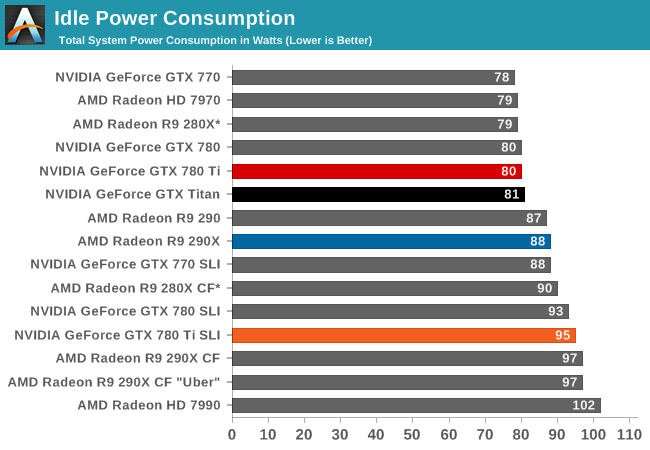
With all of our GK110 cards sharing a common design, at idle there’s very little to differentiate them. Other than GTX Titan’s extra 3GB of VRAM, we’re essentially looking at identical cards when idling.
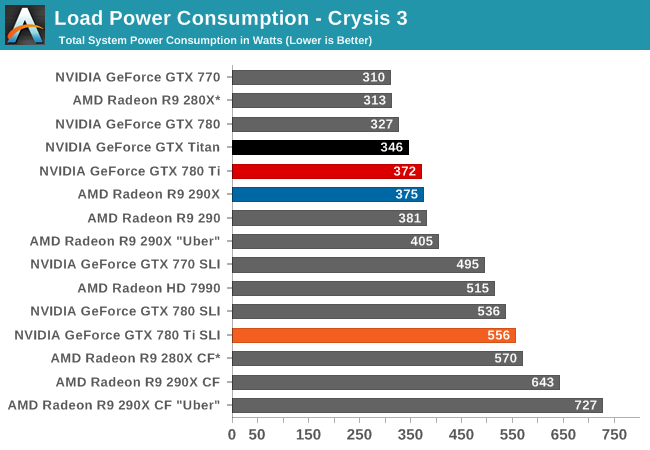
Moving on to load power, we can see the power/heat ramifications of the slight clockspeed increase coupled with the activation of the 15th SMX. Even with the further optimizations NVIDIA has put into the new revision of GK110, power consumption has gone up in accordance with the higher performance of the card, just as we’d expect. Since NVIDIA doesn’t notably alter their power efficiency here, that increased performance has to come at the cost of increased power consumption. Though in this benchmark it’s worth pointing out that we’re measuring from the wall and that GTX 780 Ti outperforms GTX Titan by 8%, so some of that 29W power difference will come from the higher CPU load caused by the increased framerates.
As for the GTX 780 Ti SLI, here we see power level off at 556W, 20W more than the GTX 780 SLI. Some (if not most) of that is going to be explained by the increased CPU power consumption from the GTX 780 Ti SLI’s higher framerates. Coupled with that is the fact that in SLI setups these cards get hotter, and hence have to downclock a bit more to maintain equilibrium, which helps to offset the increased power requirements of GTX 780 Ti and keep the SLI results so close to the GTX 780 SLI results.
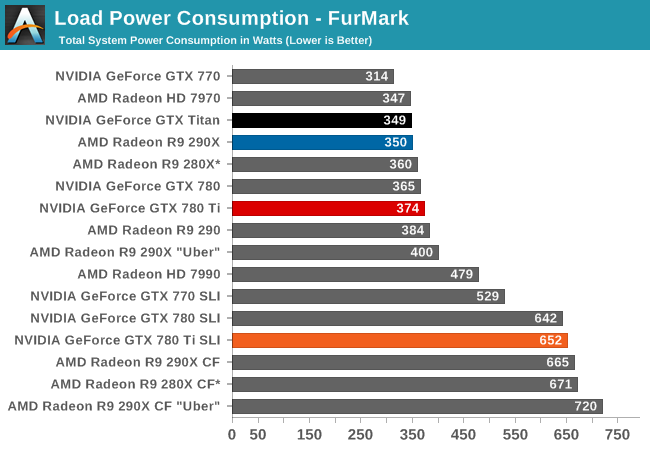
Switching over to FurMark, we find that power consumption is also up, but only slightly. With GPU Boost 2.0 clamping down on power consumption all of our GK110 cards should be clamped at 250W here, and with a difference between GTX 780 and GTX 780 Ti of under 10W, that’s exactly what appears to be happening here.
On a side note, it’s interesting to note here that under FurMark we’re seeing the GTX 780 Ti draw more power than the Radeon R9 290X. Despite the fact that the 290X has a higher rated TDP, in the card’s default quiet mode the card can’t actually dissipate as much heat (and thereby consume as much power) as the GTX 780 Ti can.
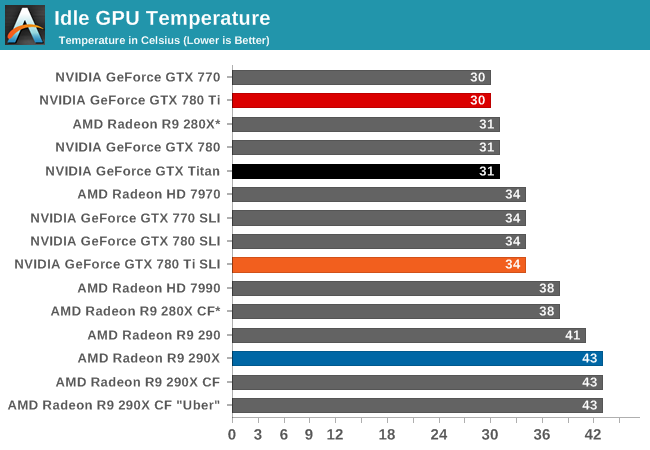
For idle temperatures we’re once again looking at cards that are for all intents and purposes identical. At 30C the GTX 780 Ti easily stays nice and cool.
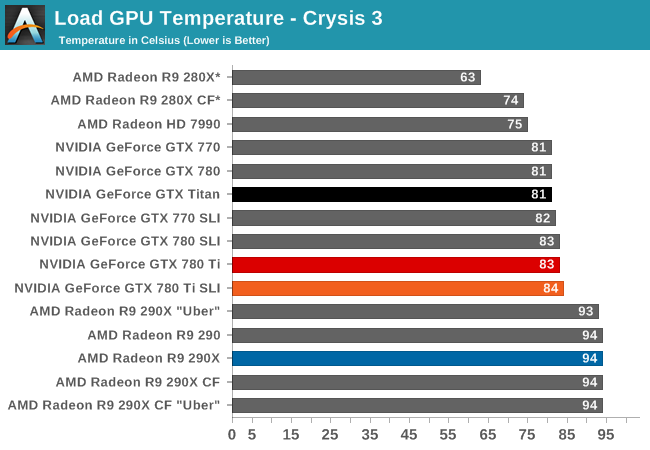
As we mentioned in our look at the GTX 780 Ti hardware, NVIDIA has increased their default temperature throttle point from 80C on the GTX Titan/780 to 83C on the GTX 780 Ti. The end result is that in all of our temperature limited tests the GTX 780 Ti will peak at 83C-84C, whereas the older GK110 cards will peak at 80C-81C.

FurMark reiterates what we saw with Crysis 3. The temps are up a bit across the board, while the GK110 cards are holding near their throttle points. The SLI setups meanwhile approach the upper-80s at 88C, reflecting the fact that even with blowers, there’s some impact on neighboring cards in high load situations.
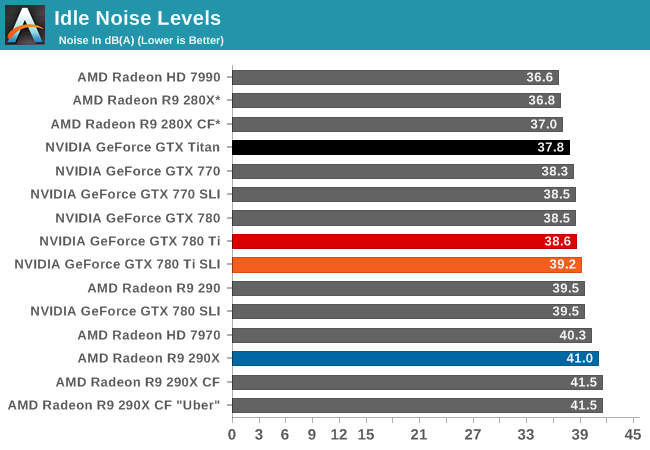
Our last idle scenario, we once again see all of our GK110 cards performing similarly, with idle noise levels in the 38dB-39dB range.
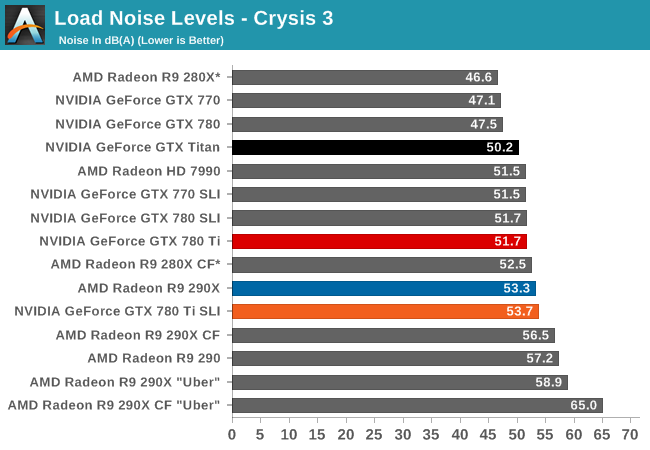
Moving on to our gaming load noise results, we can see the full repercussions of the GTX 780 Ti’s higher average power consumption coupled with the card’s higher temperature throttle point. Moving the throttle point along the same curve has the end result of moving higher the equilibrium point and thereby the card’s operating noise levels. As the fastest single-GPU card on this card, the GTX 780 Ti is still doing very well for itself and for a blower based design at 51.7dB, though at 1.5dB louder than GTX Titan and 4.2dB louder than GTX 780 the noise tradeoff for the card’s higher performance is very clear. Meanwhile the fact that it’s tied with the GTX 780 SLI comes with its own bit of irony.
Speaking of the GTX 780 SLI, we can see the noise impact of SLI configurations too. The GTX 780 Ti SLI levels out at 53.7dB, 2dB louder than our single-card configuration and 2dB louder than the GTX 780 SLI. At this point it’s just a bit louder than the 290X and quieter than a number of other 290 series setups.
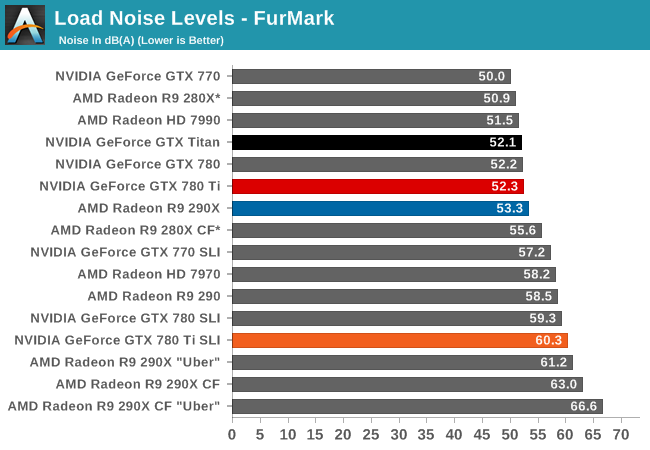
Finally with load noise levels under FurMark we can see where our various cards will peak at for noise levels. The GTX 780 Ti creeps up to 52.3dB, essentially tying with the GTX 780 and GTX Titan. Otherwise it comes in just behind the 290X, and the start of the pack for our multi-GPU setups.
As for the GTX 780 Ti SLI, like our single-card comparison points its up slightly as compared to the GTX 780 SLI.
Overall, our look at power, temperatures, and noise has been a rather straightforward validation of our earlier suspicions. GTX 780 Ti’s higher performance leads to higher power consumption, and will all other factors being held equal – including the cooler – power, temps, and noise levels all rise a bit as compared to GTX Titan and GTX 780. There’s no such thing as a free lunch here, and while GPU Boost 2.0 will keep the maximum levels suitably in check, on average GTX 780 Ti is going to be a bit worse than the other GK110 cards due to those factors. Though even with the increased noise levels in particular, GTX 780 Ti is still able to outperform 290X on noise while also delivering better gaming performance, which makes this another tidy victory for NVIDIA.










302 Comments
View All Comments
A5 - Thursday, November 7, 2013 - link
BF4 has a built-in benchmark too, but I have no idea how good it is. I'd guess they're waiting on a patch?If nothing else, there will be BF4 results if/when that Mantle update comes out.
IanCutress - Thursday, November 7, 2013 - link
BF4 has a built in benchmark tool? I can't find any reference to one.Ryan Smith - Thursday, November 7, 2013 - link
BF3 will ultimately get replaced with BF4 later this month. For the moment with all of the launches in the past few weeks, we haven't yet had the time to sit down and validate BF4, let alone collect all of the necessary data.1Angelreloaded - Thursday, November 7, 2013 - link
Hell man people run FEAR still as a benchmark because of how brutal it is against GPU/CPU/HDD.Bakes - Thursday, November 7, 2013 - link
I think it's better to wait until driver performance stabilizes for new applications before basing benchmarks on them. If you don't then early benchmark numbers become useless for comparison sake.TheJian - Thursday, November 7, 2013 - link
I would argue warhead needs to go. Servers for that game have been EMPTY for ages and ZERO people play it. You can ask to add BF4, but to remove BF3 given warhead is included (while claiming bf3 old) is ridiculous. How old is Warhead? 7-8 years? People still play BF3. A LOT of people. I would argue they need to start benchmarking based on game sales.Starcraft2, Diablo3, World of Warcraft Pandaria, COD Black ops 2, SplinterCell Blacklist, Assassins Creed 3 etc etc... IE, black ops 2 has over 5x the sales of Hitman Absolution. Which one should you be benchmarking?
Warhead...OLD.
Grid 2 .03 total sales for PC says vgchartz
StarCraft 2 5.2.mil units (just PC).
Which do you think should be benchmarked?
Even Crysis 3 only has .27mil units says vgchartz.
Diablo 3? ROFL...3.18mil for PC. So again, 11.5x Crysis 3.
Why are we not benchmarking games that are being sold in the MILLIONS of units?
WOW still has 7 million people playing and it can slow down a lot with tons of people doing raids etc.
TheinsanegamerN - Friday, November 8, 2013 - link
because any halfway decent machine can run WoW? they use the most demanding games to show how powerful the gpu really is. 5760x1080p with 4xMSAA gets 69 FPS with the 780ti.why benchmark hitman over black ops? simple, it is not what we call demanding.
they use demanding games. not the super popular games thatll run on hardware from 3 years ago.
powerarmour - Thursday, November 7, 2013 - link
Well, that time on the throne for the 290X lasted about as long as Ned Stark...Da W - Thursday, November 7, 2013 - link
I look at 4K gaming since i play in 3X1 eyefinity (being +/- 3.5K gaming).At these resolution i see an average of 1FPS lead for 780Ti over 290X. For 200$ more.
Power consumption is about the same.
And as far as temperature go, it's temperature AT THE CHIP level. Both cards will heat your room equally if they consume as much power.
The debate is really about the cooler, and Nvidia got an outright lead as far as cooling goes.
JDG1980 - Thursday, November 7, 2013 - link
It seems to me that both Nvidia and AMD are charging too much of a price premium for their top-end cards. The GTX 780 Ti isn't worth $200 more than the standard GTX 780, and the R9 290X isn't worth $150 more than the standard R9 290.For gamers who want a high-end product but don't want to unnecessarily waste money, it seems like the real competition is between the R9 290 ($399) and the GTX 780 ($499). At the moment the R9 290 has noise issues, but once non-reference cards become available (supposedly by the end of this month), AMD should hold a comfortable lead. That said, the Titan Cooler is indeed a really nice piece of industrial design, and I can see someone willing to pay a bit extra for it.